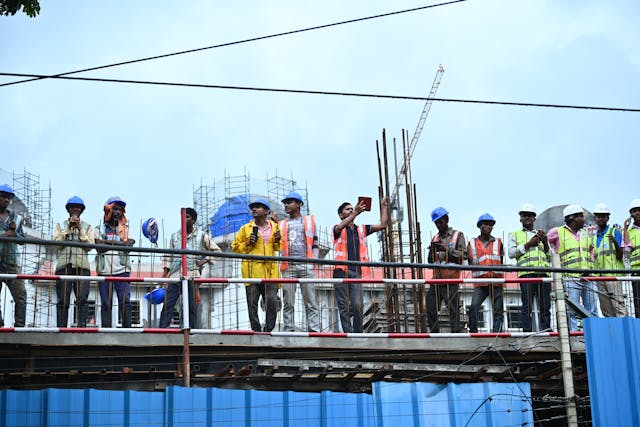Pros and Cons of Union vs Non-Union Construction Projects


In the ever-evolving world of construction, project delivery methods and workforce composition play a pivotal role in shaping timelines, costs, and outcomes. At the heart of this discussion lies the choice between union construction projects and their non-union (open shop) counterparts.
Both labor models come with distinct advantages and challenges, but understanding these differences is essential as the industry faces rising costs, ongoing labor shortages, and a shifting regulatory landscape.
This article examines the fundamental differences between union and non-union construction, provides an in-depth look at the pros and cons of each, and offers guidance on when to choose one over the other.
Whether you are a project owner, contractor, or tradesperson, this comparison will help you make informed decisions that best align with your project goals.
What Is Union vs Non-union Construction?
Definition of Union Labor
Union labor refers to construction workers who are members of trade unions. These unions, such as the International Brotherhood of Electrical Workers (IBEW) or the United Brotherhood of Carpenters (UBC), negotiate collective bargaining agreements that establish set wages, benefits, and working conditions for their members. The union serves as an intermediary between workers and employers, ensuring fair treatment, consistent standards, and workplace protections.
Definition of Non-union (Open Shop) Labor
Non-union—or open shop—labor describes a setting where workers are not bound by collective bargaining agreements or union membership. Instead, wages, benefits, and working conditions are typically negotiated individually between contractors and employees, allowing for more flexibility but less uniformity. Non-union labor makes up the majority of the U.S. construction workforce.
Key Differences in Hiring, Oversight, and Management
Understanding these foundational distinctions is crucial for evaluating the suitability of union construction projects for various types of work.
Pros and Cons of Union Construction Projects
Key Differences in Hiring, Oversight, and Management

Pros
- Skilled Workforce and Robust Training
- Union workers typically undergo extensive apprenticeship and training programs, resulting in a consistently higher skill level and productivity. This often translates to better quality work and fewer mistakes or rework.
- Predictable Labor Costs
- Union projects offer standardized wages and benefits, making labor costs more predictable. This predictability aids in accurate project budgeting and reduces risks associated with wage fluctuations.
- Higher Efficiency and Productivity
- Studies show that union laborers are up to 14% more productive than their open-shop counterparts, and projects with union labor experience reduced turnover and fewer delays.
- Strong Workplace Protections
- Unionized workers typically benefit from greater job security, equitable treatment, and protection against unfair dismissal, as well as formal grievance resolution channels.
- Better Safety Records
- Union training programs emphasize safety, and union jobsites generally have fewer OSHA violations and accidents due to rigorous safety standards and oversight.
- Workforce Availability
- Unions invest heavily in training, helping to mitigate labor shortages by maintaining a more stable and qualified workforce pool.
- Guaranteed Benefits
- Union positions often come with comprehensive benefits, including health insurance, retirement plans, and paid leave.
Cons

- Higher Costs
- While studies dispute the absolute cost difference, union labor is generally perceived as more expensive due to negotiated wage rates and benefits.
- Reduced Flexibility
- Strict union rules can limit a project’s flexibility regarding work assignments, overtime, and adapting to changing project conditions. Contractors have less discretion over personnel matters and schedules.
- Administrative Complexity
- Union projects often require compliance with extensive documentation, reporting, and labor agreements, adding to administrative overhead.
- Risk of Strikes
- Union projects carry the risk of labor strikes, which can halt work and delay completion, sometimes with significant financial impact.
- Membership Fees and Dues
- Workers must pay union dues, which can marginally decrease their take-home pay; however, these are generally outweighed by the improved earnings and benefits.
Pros
- Potentially Lower Labor Costs
- Wages and benefits can be negotiated directly and flexibly between the employer and the worker, which may result in lower upfront labor costs.
- Greater Flexibility
- Contractors have more freedom to hire, fire, set hours, and assign work as project circumstances change. Non-union labor may be more adaptable to fluctuating project demands.
- Streamlined Project Management
- Without collective bargaining restrictions, project managers can make faster decisions, potentially speeding up some aspects of the construction process.
- Direct Oversight
- Contractors have more direct control over the workforce, potentially fostering higher accountability and quicker problem resolution.
Cons

- Inconsistent Skill Levels
- The lack of standardized training can lead to variable skillsets across the workforce, sometimes resulting in lower productivity or quality issues if not properly managed.
- Less Predictable Costs
- While labor may initially be cheaper, unanticipated wage negotiations, turnover, or delay costs can erode savings over the project lifecycle.
- Limited Benefits
- Non-union workers often receive fewer benefits, which can impact morale and retention. If competitive benefits are provided, cost advantages may disappear.
- Greater Labor Turnover
- With low job security and weak benefits, non-union job sites often experience higher turnover rates, which can slow project progress and increase training costs.
- Potential for Workplace Disputes
- Without formal grievance procedures, disputes may become disruptive, increasing the risk of inefficiencies or legal challenges.
- Variable Safety Outcomes
- While some contractors maintain high safety standards, non-union sites are statistically more likely to experience OSHA violations and safety incidents.
When to Choose Union vs Non-union

Making the right choice between union construction projects and non-union approaches depends heavily on your project’s priorities, scale, location, and complexity.
When to Consider Union Construction:
- Large-scale or complex projects that demand a highly skilled workforce
- When scheduling, predictability, safety, and quality control are non-negotiable.
- Projects subject to government or prevailing wage mandates
- When labor supply stability is critical, such as during skilled worker shortages
- Environments where labor regulations or project scope necessitate strict compliance
When to Consider Non-union Construction:
- Smaller projects or those with tight budgets and fast-changing requirements
- Markets with easy access to reliable non-union talent
- When maximum flexibility in staffing, task assignment, and scheduling is needed
- Where relationships and trust with specific non-union contractors are established
Hybrid models—where union and non-union labor combine—are becoming more common, especially for projects seeking to balance cost, availability, and specialized talent.
Union and non-union construction projects each offer a unique set of strengths and trade-offs. Union construction projects provide reliable quality, skilled labor, predictable costs, and robust worker protections, but can come with higher administrative complexity and less flexibility. Non-union projects may offer lower initial costs and greater adaptability; however, they often carry a higher risk of skill gaps, turnover, and variable outcomes.
The optimal choice depends on project goals, risk tolerance, regulatory landscape, and labor market realities. Rather than defaulting to a preference, project owners and managers should weigh these factors carefully to ensure the best fit for each project’s specific needs. A balanced, informed approach is the key to long-term success in today’s rapidly changing construction industry.
Lorem ipsum dolor sit amet, consectetur adipiscing elit. Donec ullamcorper mattis lorem non. Ultrices praesent amet ipsum justo massa. Eu dolor aliquet risus gravida nunc at feugiat consequat purus. Non massa enim vitae duis mattis. Vel in ultricies vel fringilla.
Introduction
Mi tincidunt elit, id quisque ligula ac diam, amet. Vel etiam suspendisse morbi eleifend faucibus eget vestibulum felis. Dictum quis montes, sit sit. Tellus aliquam enim urna, etiam. Mauris posuere vulputate arcu amet, vitae nisi, tellus tincidunt. At feugiat sapien varius id.
Eget quis mi enim, leo lacinia pharetra, semper. Eget in volutpat mollis at volutpat lectus velit, sed auctor. Porttitor fames arcu quis fusce augue enim. Quis at habitant diam at. Suscipit tristique risus, at donec. In turpis vel et quam imperdiet. Ipsum molestie aliquet sodales id est ac volutpat.

Ipsum sit mattis nulla quam nulla. Gravida id gravida ac enim mauris id. Non pellentesque congue eget consectetur turpis. Sapien, dictum molestie sem tempor. Diam elit, orci, tincidunt aenean tempus. Quis velit eget ut tortor tellus. Sed vel, congue felis elit erat nam nibh orci.
Dolor enim eu tortor urna sed duis nulla. Aliquam vestibulum, nulla odio nisl vitae. In aliquet pellentesque aenean hac vestibulum turpis mi bibendum diam. Tempor integer aliquam in vitae malesuada fringilla.
Elit nisi in eleifend sed nisi. Pulvinar at orci, proin imperdiet commodo consectetur convallis risus. Sed condimentum enim dignissim adipiscing faucibus consequat, urna. Viverra purus et erat auctor aliquam. Risus, volutpat vulputate posuere purus sit congue convallis aliquet. Arcu id augue ut feugiat donec porttitor neque. Mauris, neque ultricies eu vestibulum, bibendum quam lorem id. Dolor lacus, eget nunc lectus in tellus, pharetra, porttitor.
Ipsum sit mattis nulla quam nulla. Gravida id gravida ac enim mauris id. Non pellentesque congue eget consectetur turpis. Sapien, dictum molestie sem tempor. Diam elit, orci, tincidunt aenean tempus. Quis velit eget ut tortor tellus. Sed vel, congue felis elit erat nam nibh orci.
Mi tincidunt elit, id quisque ligula ac diam, amet. Vel etiam suspendisse morbi eleifend faucibus eget vestibulum felis. Dictum quis montes, sit sit. Tellus aliquam enim urna, etiam. Mauris posuere vulputate arcu amet, vitae nisi, tellus tincidunt. At feugiat sapien varius id.
Eget quis mi enim, leo lacinia pharetra, semper. Eget in volutpat mollis at volutpat lectus velit, sed auctor. Porttitor fames arcu quis fusce augue enim. Quis at habitant diam at. Suscipit tristique risus, at donec. In turpis vel et quam imperdiet. Ipsum molestie aliquet sodales id est ac volutpat.
Mi tincidunt elit, id quisque ligula ac diam, amet. Vel etiam suspendisse morbi eleifend faucibus eget vestibulum felis. Dictum quis montes, sit sit. Tellus aliquam enim urna, etiam. Mauris posuere vulputate arcu amet, vitae nisi, tellus tincidunt. At feugiat sapien varius id.
Eget quis mi enim, leo lacinia pharetra, semper. Eget in volutpat mollis at volutpat lectus velit, sed auctor. Porttitor fames arcu quis fusce augue enim. Quis at habitant diam at. Suscipit tristique risus, at donec. In turpis vel et quam imperdiet. Ipsum molestie aliquet sodales id est ac volutpat.
- Lectus id duis vitae porttitor enim gravida morbi.
- Eu turpis posuere semper feugiat volutpat elit, ultrices suspendisse. Auctor vel in vitae placerat.
- Suspendisse maecenas ac donec scelerisque diam sed est duis purus.

Lectus leo massa amet posuere. Malesuada mattis non convallis quisque. Libero sit et imperdiet bibendum quisque dictum vestibulum in non. Pretium ultricies tempor non est diam. Enim ut enim amet amet integer cursus. Sit ac commodo pretium sed etiam turpis suspendisse at.
Tristique odio senectus nam posuere ornare leo metus, ultricies. Blandit duis ultricies vulputate morbi feugiat cras placerat elit. Aliquam tellus lorem sed ac. Montes, sed mattis pellentesque suscipit accumsan. Cursus viverra aenean magna risus elementum faucibus molestie pellentesque. Arcu ultricies sed mauris vestibulum.
Essential resources for contractors








